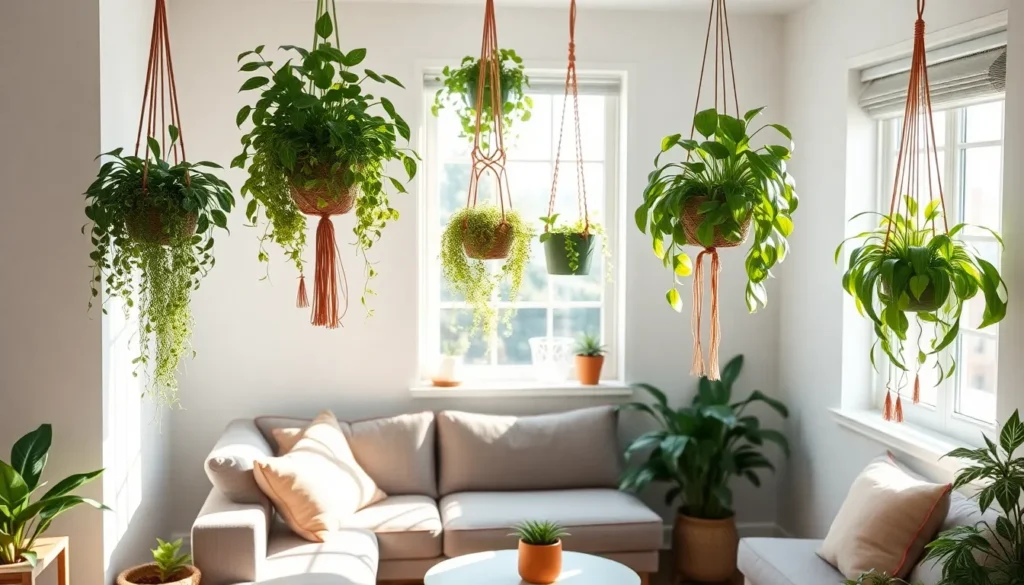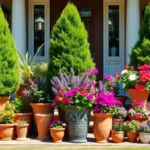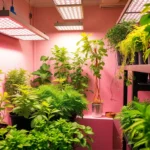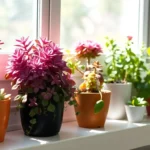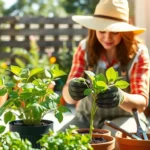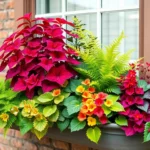We’ve all walked into a room and felt something was missing – that perfect touch to make the space feel alive and complete. Hanging plants transform ordinary living rooms into vibrant sanctuaries that breathe life into every corner. They’re not just decorative elements; they’re natural air purifiers that create vertical gardens in spaces where floor room is precious.
The beauty of indoor hanging plants lies in their versatility and impact. Whether you’re working with a cozy apartment or a spacious family room, these elevated green companions add depth and dimension that traditional potted plants simply can’t match. They draw the eye upward while creating natural focal points that make your living space feel more ever-changing and welcoming.
We’ll show you how to select the perfect hanging plants for your living room’s lighting conditions, choose containers that complement your décor, and master the art of placement for maximum visual impact.
Choose the Right Hanging Plants for Your Indoor Living Room
Selecting appropriate hanging plants for your indoor living room transforms your space while ensuring long term success with minimal maintenance. We’ll guide you through essential categories that accommodate different living conditions and household needs.
Low-Light Tolerant Varieties
ZZ plants thrive in dimly lit corners where other hanging varieties struggle to survive. These glossy-leafed beauties require watering only once every 2-3 weeks and tolerate neglect exceptionally well.
Pothos varieties flourish in low to medium light conditions while trailing gracefully from elevated containers. Golden pothos, marble queen pothos, and neon pothos create stunning cascades that reach 6-8 feet in length with proper care.
Philodendrons adapt to various lighting situations while producing heart-shaped leaves that add romantic appeal to living spaces. Heartleaf philodendrons and brasil philodendrons grow rapidly in hanging baskets placed away from direct sunlight.
Spider plants develop long, arching leaves with baby plantlets that dangle like natural ornaments. These resilient performers tolerate low light environments while producing white flowers and offspring for propagation.
Pet-Safe Options
Boston ferns provide lush, feathery foliage without posing toxicity risks to cats and dogs. These humidity-loving plants create dense, cascading displays that soften hard architectural lines in modern living rooms.
Spider plants offer double benefits as both low-light performers and completely safe options for pet owners. Their ribbon-like leaves and dangling plantlets satisfy curious pets without causing health concerns.
Parlor palms bring tropical elegance to hanging displays while remaining non-toxic to household animals. These slow-growing palms develop graceful fronds that sway gently in air currents from heating and cooling systems.
Prayer plants showcase striking leaf patterns with purple undersides that fold upward each evening. Calathea varieties like rattlesnake plants and peacock plants create living art pieces that pose zero danger to pets.
Air-Purifying Species
English ivy removes formaldehyde, benzene, and airborne mold particles while creating dense, trailing coverage. This vigorous grower produces cascades of small, lobed leaves that filter indoor air pollutants effectively.
Pothos varieties eliminate formaldehyde, xylene, and toluene from living room air while requiring minimal maintenance. NASA studies confirm these trailing beauties rank among the top 10 air-cleaning houseplants for indoor environments.
Spider plants combat formaldehyde and xylene while producing oxygen at higher rates than most hanging varieties. Their grass-like foliage and plantlet offspring create natural air filtration systems that work continuously.
Boston ferns increase humidity levels while removing pollutants like formaldehyde and xylene from indoor air. These feathery performers release moisture that combats dry air conditions common in heated and air-conditioned living spaces.
Select the Perfect Hanging Planters and Containers

Choosing the right hanging planters and containers forms the foundation for creating stunning vertical displays in our living rooms. Our selection directly impacts both plant health and visual appeal throughout the space.
Macrame Plant Hangers
Macrame hangers offer the perfect blend of functionality and bohemian style for our indoor hanging displays. These knotted cord structures provide excellent support for various pot sizes while adding rustic charm to any living room décor. We can easily adjust most macrame designs to accommodate different container shapes and weights.
Versatility makes macrame hangers particularly appealing since they work with both ceiling hooks and wall brackets. The natural fibers complement trailing plants like Burro’s Tail or Chain of Hearts beautifully. We’ll find that macrame hangers raise our plants to eye level, maximizing the visual impact of cascading foliage throughout the room.
Installation requires minimal hardware, making these hangers ideal for renters or those who prefer temporary answers. Most macrame styles can hold containers ranging from 4 to 12 inches in diameter without modification.
Ceiling-Mounted Hooks and Hardware
Ceiling mounted systems maximize our floor and shelf space while creating dramatic vertical displays above eye level. We need sturdy H2 hooks securely anchored in ceiling joists to support the weight of plants, soil, and containers safely.
Strategic placement in low traffic areas prevents plant damage and keeps trailing vines from catching on people walking beneath. Boston Ferns and trailing pothos thrive in these elevated positions where their foliage can cascade freely. We should position ceiling hooks at least 8 feet from frequently used pathways.
Weight capacity becomes crucial when selecting ceiling hardware, especially for larger plants or self watering planters. Most residential ceiling joists can support 15 to 25 pounds per hook when properly installed with appropriate anchoring systems.
Wall-Mounted Bracket Systems
Wall brackets create stunning “green curtains” that transform unused wall space into living art installations. We can mount these systems near windows to optimize sunlight exposure for light loving plants like English Ivy or Hoya varieties.
Cascading displays work exceptionally well with wall mounted brackets since plants can trail downward naturally. This creates vertical greenery that enhances our biophilic living room atmosphere while utilizing previously empty wall areas. We’ll achieve the most dramatic effects by installing brackets at varying heights.
Window proximity allows us to take advantage of natural light patterns throughout the day. Plants positioned on wall brackets near south facing windows receive optimal illumination for healthy growth and vibrant foliage displays.
Determine the Best Placement for Maximum Visual Impact
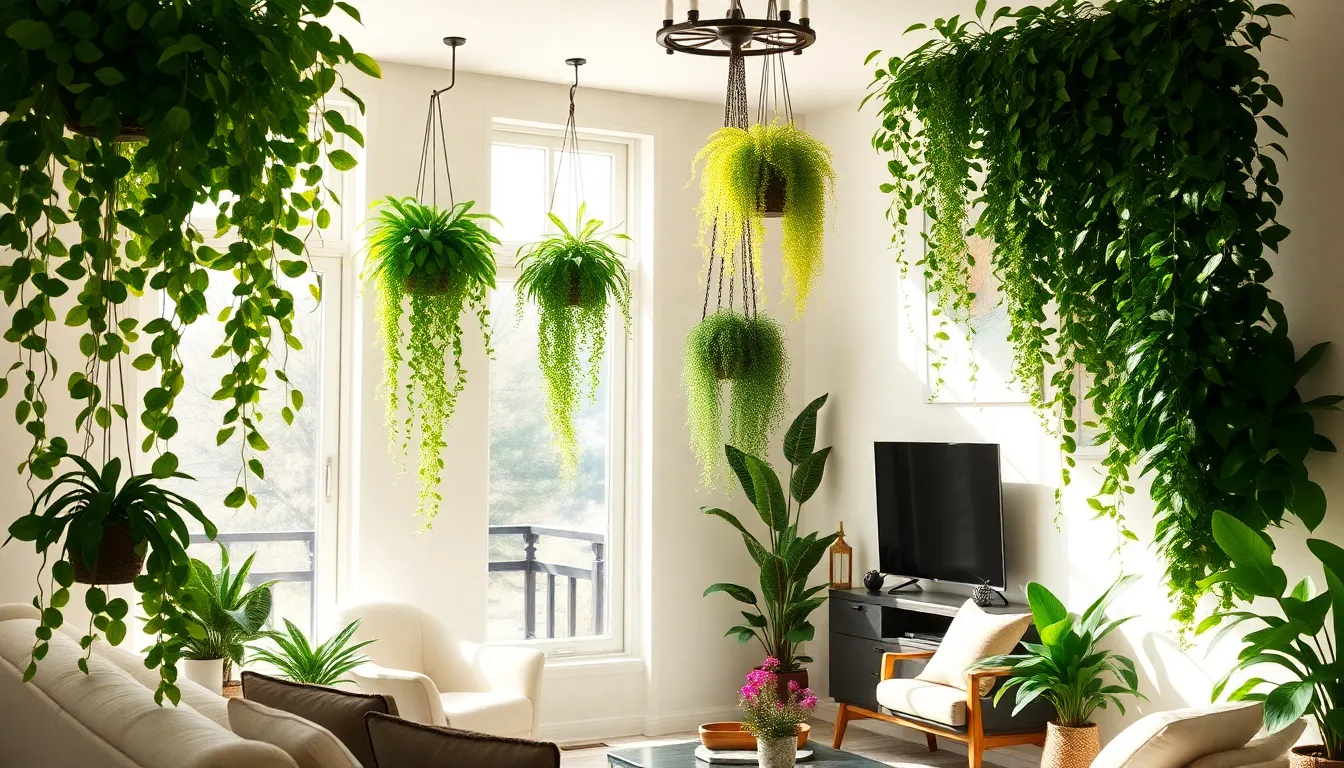
Strategic placement transforms hanging plants from simple greenery into powerful design elements that reshape your living room’s entire atmosphere. We’ll explore the most effective locations that maximize both visual appeal and plant health.
Corner Spaces and Awkward Areas
Corner spaces offer untapped potential for creating dramatic focal points with hanging plants. We recommend utilizing corners near windows where natural light creates the perfect growing conditions while transforming overlooked areas into lush, layered displays.
Empty corners become vibrant vertical gardens when we position hanging planters at different heights. This approach creates depth and visual interest without crowding the main living areas. Trailing plants like pothos or philodendrons work exceptionally well in these spaces, cascading down to soften sharp architectural lines.
Awkward nooks and unused vertical spaces gain new purpose when we incorporate hanging plants strategically. These challenging areas often become conversation starters and unique design features that showcase our creativity in maximizing every inch of living space.
Near Windows for Natural Light
Window placement provides the optimal growing conditions most hanging plants require while creating stunning natural frames for your views. We position trailing plants and sun loving varieties near windows to ensure they receive adequate light for healthy growth and vibrant foliage.
Natural light streaming through windows illuminates hanging plants beautifully throughout the day, creating ever-changing shadows and highlights that change with the sun’s movement. This positioning allows us to showcase the natural beauty of cascading leaves while maintaining clear sightlines through the glass.
Strategic window placement requires careful consideration to avoid blocking essential natural light or obstructing views entirely. We recommend hanging plants slightly to the side of windows rather than directly in front, preserving both plant health and room functionality.
Above Furniture and Seating Areas
Furniture adjacent placement creates intimate green spaces without overwhelming the areas where we relax and socialize. We position hanging plants to the side of sofas, lounge chairs, and desks rather than directly overhead to maintain comfortable proportions and prevent feelings of enclosure.
Seating areas benefit from nearby hanging plants that add natural elements to conversation zones while respecting personal space. This positioning integrates greenery into our daily living activities without creating physical barriers or safety concerns.
Desk and workspace areas gain enhanced productivity benefits when we incorporate hanging plants nearby. The presence of greenery reduces stress and improves air quality in spaces where we spend extended periods, creating healthier and more inspiring work environments.
Install Proper Support Systems for Safety and Stability

Proper installation techniques and support systems form the foundation of safe hanging plant displays in our living rooms. We’ll ensure our plants remain securely positioned while protecting both our investment and our family’s safety.
Ceiling Joist Location and Weight Distribution
Ceiling joists provide the strongest anchor points for hanging plants, supporting 30+ pounds safely when properly installed. We use stud finders to locate these structural beams before drilling, ensuring our hooks connect directly to solid wood rather than hollow drywall.
Weight distribution becomes crucial when hanging multiple plants in close proximity. We group lighter plants together and spread heavier specimens across different joists to prevent overloading any single point. This approach maintains structural integrity while creating balanced visual displays.
Tension rods offer alternative answers when ceiling joists aren’t accessible in our desired locations. We position these between walls or in doorways to support lighter plants without compromising ceiling structure. Multiple mounting points help distribute weight evenly across the support system.
Toggle Bolts and Heavy-Duty Anchors
Toggle bolts with swag hooks support plants weighing 15-20 pounds in drywall ceilings without accessible joists. We drill 5/8 inch holes and insert folded toggle bolts through our hooks before pushing them completely through the ceiling opening.
Expansion behind the drywall creates secure anchoring as we tighten the bolts against the ceiling surface. We ensure the toggle wings fully deploy before applying final tension to maximize holding power. Regular inspection helps us identify any loosening before it becomes problematic.
Heavy duty anchors provide reliable alternatives when toggle bolts aren’t suitable for our exact ceiling material. We select anchors rated for twice our plant’s actual weight to maintain safety margins. Metal construction offers superior durability compared to plastic alternatives in high stress applications.
Professional Installation Considerations
Professional installation becomes essential for plants exceeding 20 pounds or when we’re uncertain about our ceiling’s structural capabilities. Contractors assess ceiling materials, locate joists accurately, and select appropriate hardware for our exact situation.
Valuable or irreplaceable plants warrant professional handling to prevent damage from improper installation attempts. We protect our investment by ensuring correct placement and secure mounting from the start. Professional assessment identifies potential structural issues before they cause problems.
Ceiling integrity evaluation helps us avoid costly damage to our living room’s structure and finishes. Contractors determine load limits and recommend reinforcement when necessary for our hanging plant displays. Their expertise prevents accidents while maximizing our design possibilities.
Maintain Proper Watering and Drainage Techniques
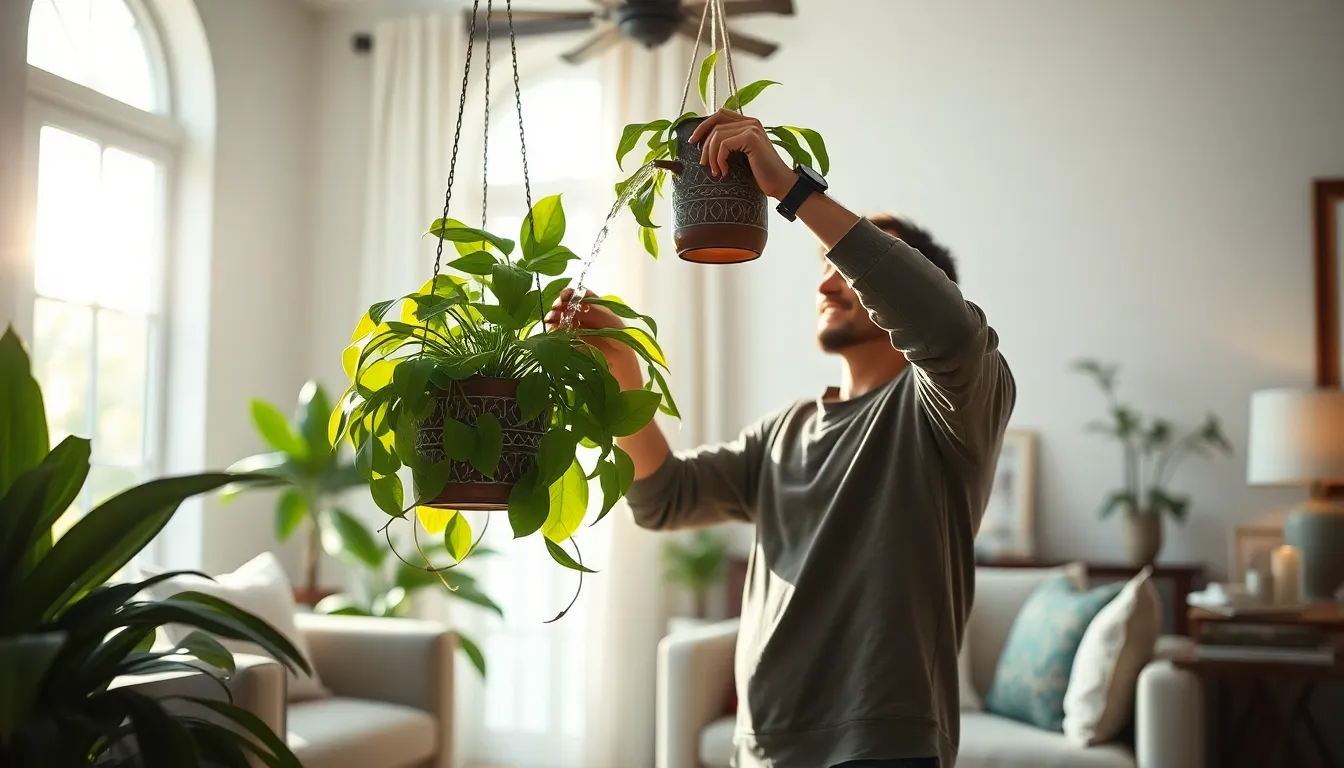
We’ve covered installation and placement strategies, but watering our hanging plants properly is where many indoor gardeners struggle. Proper drainage becomes even more critical when plants are suspended above our living spaces.
Preventing Water Damage to Floors
Protecting our floors from water damage requires strategic planning when we water our hanging plants. We recommend taking plants to a sink or shower for watering, allowing them to drain thoroughly for about 15 minutes before rehanging them. Saucers or trays placed underneath hanging pots catch excess water and prevent damage to floors or furniture beneath our displays.
Using well-aerated, lightweight potting soil helps improve drainage while reducing weight on our hanging planters. Water accumulation in pots causes root damage and fungal problems that can destroy our plants and create messy drips. We can minimize floor protection concerns by ensuring plants are completely drained before returning them to their hanging positions.
Self-Watering Systems and Saucers
Self-watering pots revolutionize how we care for our hanging plants by utilizing reservoirs that provide steady moisture supply. These systems reduce watering frequency and eliminate the risk of both over-watering and under-watering our suspended gardens. We find that self-watering systems work particularly well in indoor environments where overwatering commonly occurs.
Saucers serve as our first line of defense against water mess and damage in living rooms. Quality saucers catch excess water while maintaining the aesthetic appeal of our hanging displays. We can choose decorative saucers that complement our plant containers and room decor, making water management both functional and stylish.
Seasonal Watering Adjustments
Our hanging plants’ watering needs change dramatically with seasons and indoor climate conditions. During warmer months or in dry indoor air, we’ll need to water more frequently as soil dries faster in elevated positions. Conversely, cooler months or higher indoor humidity require reduced watering to prevent waterlogging in our suspended plants.
We should observe soil moisture levels and plant appearance to guide our watering schedule adjustments throughout the year. Plants positioned near heating vents or air conditioning units may need more frequent attention than those in stable climate zones. Seasonal adjustments help us maintain healthy, vibrant hanging plants that enhance our living rooms year-round.
Create Stunning Visual Arrangements and Groupings
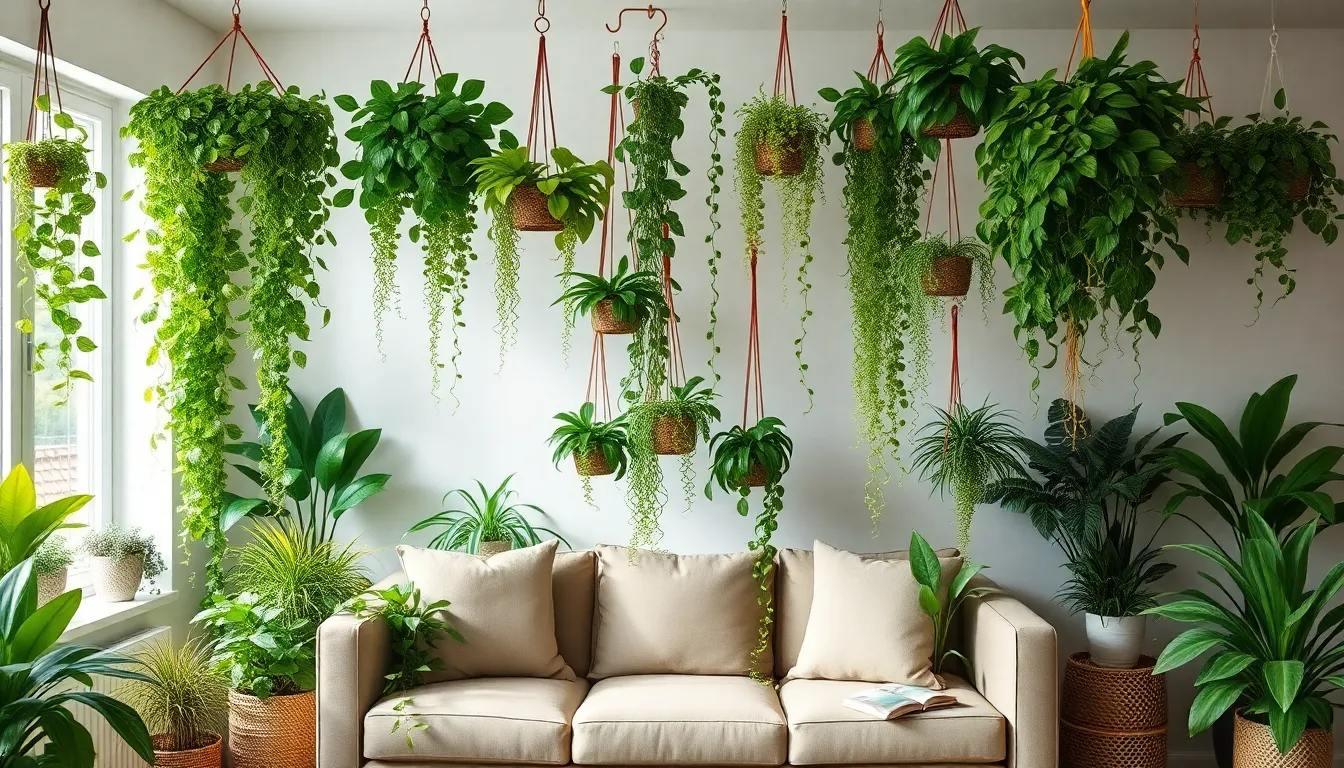
Clustering hanging plants together creates an impactful, lush appearance that transforms any living room into a vibrant indoor garden. Strategic groupings of different species bring rich variety and visual depth to your space.
Layering Plants at Different Heights
Staggering hanging plants at various heights adds incredible dimension and visual interest to your living room display. We recommend using ceiling hooks and wall brackets to create multiple elevation levels throughout your space. Position lower hanging plants with cascading vines like pothos and philodendrons beneath higher suspended specimens to maximize vertical real estate.
Balanced layering optimizes both space utilization and aesthetic appeal by drawing the eye upward through different plant zones. Boston ferns work beautifully at mid level positions while trailing varieties create flowing connections between upper and lower display areas. This technique transforms flat wall spaces into ever-changing three dimensional plant galleries.
Mixing Trailing and Upright Growth Patterns
Combining trailing species with upright or bushy plants creates striking contrast and ever-changing visual compositions throughout your living room. Cascading varieties like English ivy, Burro’s Tail, and Chain of Hearts flow downward while bushier specimens fill upper display areas with fuller foliage masses.
This growth pattern contrast breaks visual monotony and adds organic texture variation that mimics natural forest environments. Trailing plants soften harsh architectural lines while upright specimens provide structural anchoring points for your hanging garden design. The interplay between flowing and structured forms creates balanced arrangements that feel both planned and naturally evolved.
Color Coordination with Room Decor
Selecting plants whose leaf colors complement your existing room palette creates cohesive design integration that ties your hanging garden into the overall living space aesthetic. Green foliage harmonizes beautifully with neutral color schemes while adding fresh vitality to warm toned rooms.
Variegated hoya species and colorful leaf varieties can coordinate with accent colors found in your furniture, artwork, or textile choices. We suggest matching pot materials and colors to your room’s theme using ceramic vessels for modern spaces, wicker baskets for bohemian styles, or macrame hangers for textured natural looks. This coordination ensures your hanging plants enhance rather than compete with your existing decor elements.
Troubleshoot Common Problems with Hanging Indoor Plants
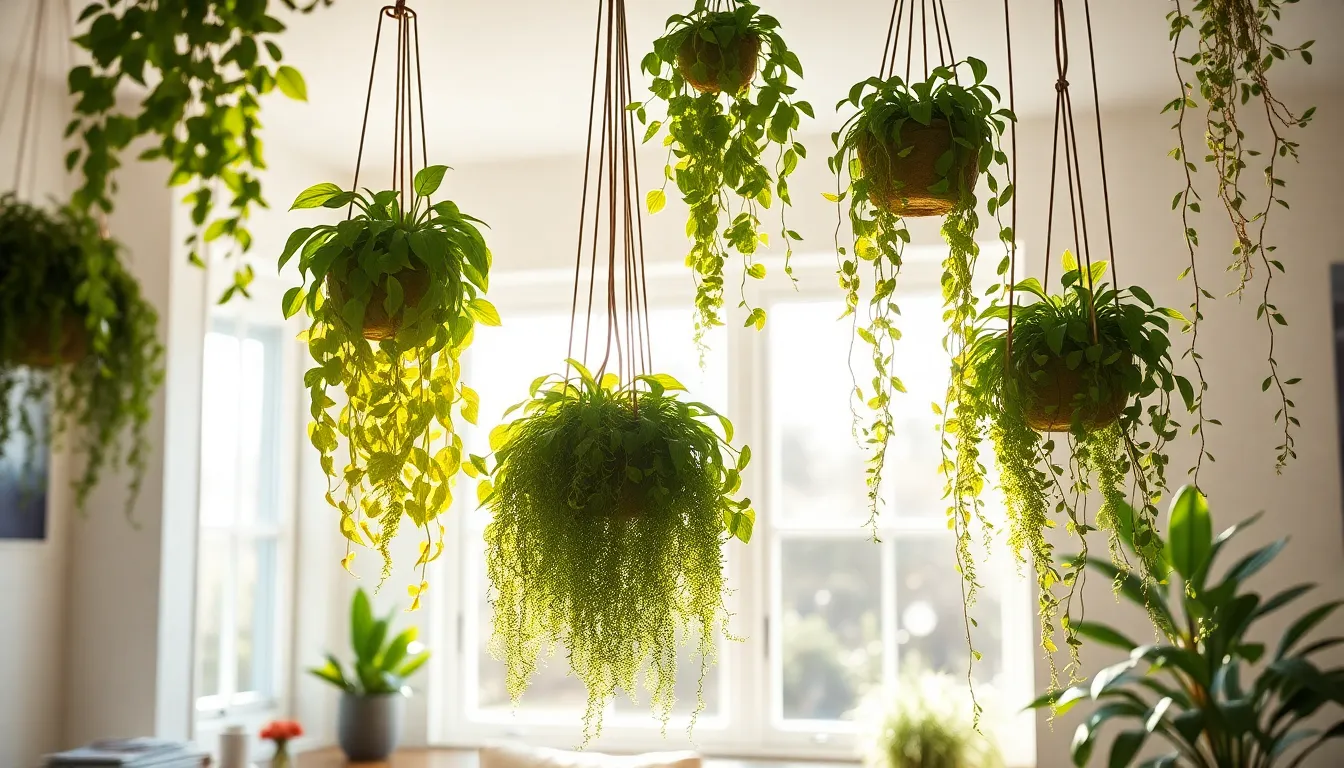
Even the most beautiful hanging plant displays can encounter challenges that require our attention and care. Let’s address the most common issues we face when maintaining elevated greenery in our living rooms.
Yellowing Leaves and Overwatering
Yellowing leaves often signal overwatering in hanging plants, which happens more frequently than we might expect. Elevated positions expose our plants to air circulation on all sides, causing them to dry out faster and making watering schedules tricky to master. We should check the top inch of soil with our finger before watering, ensuring it feels dry to the touch.
Drainage becomes critical when we’re dealing with hanging containers. Pots without proper drainage holes create waterlogged conditions that suffocate roots and cause yellowing. We need to select containers with adequate drainage and use loose, airy potting soil that absorbs water effectively while allowing excess moisture to escape.
Fertilization requires a balanced approach during the growing season. Weekly liquid fertilizer applications from spring to autumn provide necessary nutrients without overwhelming our plants. Slow release fertilizers offer an alternative solution that reduces the risk of overfeeding while maintaining consistent nutrition levels.
Pest Control in Elevated Positions
Pests become harder to detect on hanging plants due to their height and our limited viewing angles. Spider mites, aphids, and scale insects commonly target elevated plants, often establishing themselves on leaf undersides where we can’t easily spot them. Regular inspections using a step stool or ladder help us catch infestations early.
Dust accumulation makes hanging plants vulnerable to pest problems since dirty leaves create ideal conditions for insects to thrive. We should gently spray leaves with water or use safe leaf care products to maintain cleanliness. Clean foliage also improves photosynthesis and overall plant health.
Treatment applications require extra care when dealing with elevated plants. Insecticidal soaps and natural remedies work effectively, but we must avoid overwatering during pest treatments. Moving plants to ground level temporarily makes thorough treatment easier and more effective.
Managing Growth and Pruning Needs
Regular pruning maintains shape and encourages healthy development in our hanging plants. Pinching off dead or yellowing leaves prevents disease spread while keeping our displays looking their best. We should remove damaged foliage promptly to redirect energy toward new growth.
Trailing plants benefit from strategic trimming to control their size and encourage bushier growth patterns. Long vines can become overwhelming in living room spaces, so we trim them back to maintain proportional displays. This pruning also stimulates new growth points along the stems.
Repotting every 1 to 2 years ensures continued vitality for our hanging plants. Fresh soil provides renewed nutrients and prevents root bound conditions that limit growth. We should choose lightweight potting mixes specifically designed for container gardening to reduce overall weight while maintaining proper drainage and aeration.
Conclusion
We’ve explored how hanging plants can completely transform your living room into a vibrant and healthier space. From selecting the right plants for your lighting conditions to mastering proper installation and care techniques these elevated green companions offer endless possibilities for improving your home.
The key lies in thoughtful planning – choosing plants that suit your lifestyle while creating visually stunning arrangements that complement your existing decor. Whether you’re working with low-light corners or bright window areas there’s a perfect hanging plant solution waiting to elevate your space.
By implementing the strategies we’ve discussed you’ll not only create a more beautiful living environment but also enjoy the air-purifying benefits and sense of tranquility that indoor plants provide. Your living room will become a lush sanctuary that reflects your personal style while bringing nature indoors.
Frequently Asked Questions
What are the best hanging plants for low-light living rooms?
ZZ plants, pothos, philodendrons, and spider plants are excellent choices for low-light conditions. These varieties are extremely tolerant of dim environments and require minimal maintenance. They thrive in living rooms with limited natural light while still providing beautiful trailing foliage that enhances your space’s aesthetic appeal.
Which hanging plants are safe for pets?
Boston ferns, spider plants, parlor palms, and prayer plants are completely non-toxic to cats and dogs. These pet-safe options allow you to enjoy beautiful hanging greenery without worrying about your furry friends’ safety. They’re perfect for households with curious pets who might nibble on plants.
How do I choose the right hanging planter for my living room?
Consider your room’s style, the plant’s size, and weight capacity when selecting planters. Macrame hangers offer adjustable support and bohemian charm, while modern ceramic or metal containers suit contemporary spaces. Ensure the planter complements your decor and provides adequate drainage to prevent water damage.
Where should I place hanging plants for maximum visual impact?
Position hanging plants near windows to optimize light exposure while creating dramatic focal points. Corner spaces work exceptionally well for vertical gardens. Place plants above furniture and seating areas to create intimate green spaces. Stagger different heights to add dimension and visual interest to your room.
How do I safely install hanging plants in my ceiling?
Locate ceiling joists for secure anchoring using a stud finder. For drywall installations, use toggle bolts or heavy-duty anchors rated for your plant’s weight. Consider professional installation for heavier plants or uncertain ceiling structures. Always distribute weight evenly when hanging multiple plants to prevent damage.
What’s the best way to water hanging plants without damaging floors?
Water plants in a sink or shower, then allow excess water to drain before rehanging. Use saucers or drip trays to catch any remaining water. Consider self-watering systems for consistent moisture without mess. Monitor soil moisture regularly and adjust watering frequency based on seasonal changes and plant needs.
How can I create an attractive arrangement with multiple hanging plants?
Stagger plants at different heights to create visual dimension. Mix trailing varieties with upright growth patterns for striking contrasts. Coordinate plant colors with your room’s existing decor for cohesive design integration. Group plants in odd numbers and vary container styles while maintaining a unified aesthetic theme.
What are common problems with hanging plants and how do I fix them?
Yellowing leaves typically indicate overwatering – improve drainage and reduce watering frequency. Conduct regular pest inspections since elevated plants can be harder to monitor. Prune regularly to maintain shape and health. Repot when plants outgrow containers, and rotate occasionally to ensure even light exposure and growth.

